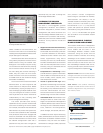
BLADE SERVERS
DELL POWER SOLUTIONS | February 200860
Reprinted from
Dell Power Solutions,
February 2008. Copyright © 2008 Dell Inc. All rights reserved.
I
n data center environments, simple, flexible server
monitoring and management tools can be critical
to maintaining efficient operations. The Avocent
iKVM (integrated keyboard, video, mouse) switch, an
analog KVM switch integrated into the Dell PowerEdge
M1000e modular blade enclosure,
1
is designed to let
administrators easily view, monitor, and manage each
of the 16 server blades in the PowerEdge M1000e and
provide access to the Dell Chassis Management
Controller (CMC) for management and power control.
Key features of the Avocent iKVM switch include local
access to each server blade, one-to-one administra-
tion for up to 16 administrators accessing each of the
16 blades, integration with the Avocent On-Screen
Configuration and Reporting (OSCAR®) graphical user
interface for configuration and to work with existing
Avocent KVM infrastructures, integration with the
Microsoft® Active Directory® directory service, and
access to the integrated Dell Remote Access
Controller (iDRAC) on each blade.
The Avocent iKVM switch is compatible with stan-
dard USB keyboards and pointing devices as well as
with VGA monitors that support Display Data Channel
(DDC). Its video connections support display resolution
ranges from 640 × 480 at 60 Hz up to 1,600 × 1,200 at
75 Hz. When necessary, administrators can update the
Avocent iKVM switch firmware through the CMC firm-
ware update utility.
USING THE AVOCENT iKVM SWITCH
The Avocent iKVM switch provides traditional KVM
switching between server blades in the Dell PowerEdge
M1000e enclosure as well as a scanning feature, which
allows administrators to scan through preselected
blades while pausing for a specific time at each blade.
They can also select a specific blade through the
OSCAR main dialog box, as shown in Figure 1. In addi-
tion to the blade names (which administrators can set
themselves or pull from the CMC automatically during
setup) and chassis slot numbers, the OSCAR interface
provides status information for each blade: a green
circle, for example, indicates that the blade is online
and functioning properly, while a red X means the blade
is offline or not functioning properly. A yellow circle
indicates that a blade is online but unavailable—for
example, because another user is controlling it remotely.
The letters in the right column provide additional infor-
mation, such as whether a blade is being accessed by
a user panel (a green letter) or blocked by a specific
user channel (a black letter), and whether the blade is
being accessed through the rear panel (the letter A)
or the front panel (the letter B). When administrators
The Avocent® iKVM (integrated keyboard, video, mouse)
switch, an analog KVM switch integrated into the Dell
™
PowerEdge
™
M1000e modular blade enclosure, is designed
to simplify administrative tasks by letting IT sta easily view,
monitor, and manage server blades and by providing access
to the remote management and power control functions of
the PowerEdge M1000e Chassis Management Controller.
By Stephen M. Hahn
Chad Fenner
MANAGING DELL
POWEREDGE M1000e
BLADE SERVERS
WITH THE AVOCENT
iKVM SWITCH
Related Categories:
Avocent
Blade servers
Visit DELL.COM/PowerSolutions
for the complete category index.
1
For more information on the PowerEdge M1000e, see “The Next-Generation Dell PowerEdge M1000e Modular Blade Enclosure,” by Chad Fenner, in Dell Power Solutions, February 2008,
DELL.COM/Downloads/Global/Power/ps1q08-20080206-Fenner.pdf.




